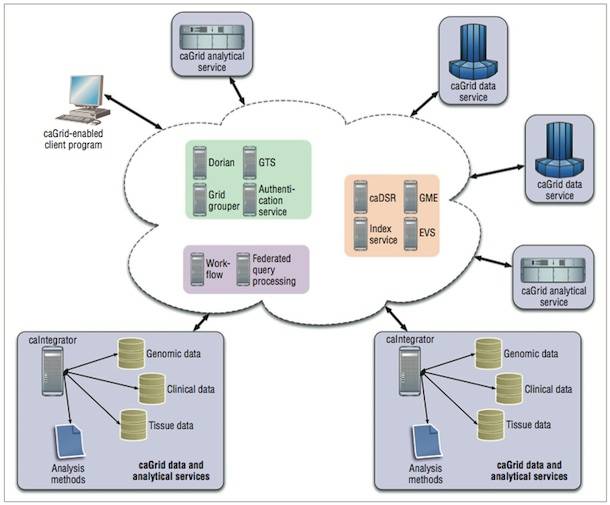
One of the promises of the cloud is the power to join computing resources to solve the scientific mysteries of our time. On the backdrop of biomedical research, the challenges to join minds and computers together are also immense. Not only is the subject material complicated, it also is sensitive from both a time and privacy point of view. It is critical to get it right as people’s lives are at stake, and any new discovery requires comprehensive peer review and an unerring trail of evidence.
With these considerations in mind, the National Cancer Institute has been making significant progress with the caBIG (Cancer Biomedical Informatics Grid) project. It is focused on setting standards for sharing computing resources and data in the effort to cure cancer.
The caBIG charter is enormous and visionary: “The National Cancer Institute is launching a 21st century information initiative that will transform the way we do cancer research. We are creating a network that will freely connect the entire cancer community. In doing so, we are leveraging valuable resources and saving precious time toward new discoveries.”
Imaging
A number of peer-reviewed articles on the use of imaging using the caBIG have been released. A paper titled “e-Science, caGrid, and Translational Biomedical Research” offers insight into the mindset of biomedical researchers.
“Translational research projects target a wide variety of diseases, test many different kinds of biomedical hypotheses, and employ a large assortment of experimental methodologies. Diverse data, complex execution environments, and demanding security and reliability requirements make the implementation of these projects extremely challenging and require novel e-Science technologies.”
To make its shared research work across the industry requires unique approaches in computing architecture. An architecture diagram gives a peek into the system that has been designed to meet the challenge.

Tools, Federation, and Semantics
One of the most impressive things about the caBIG project is the focus on metadata vocabularies and semantics. This organization is one of the first to move beyond shared computing resources to a shared conceptual workspace. Not only is this one of the hardest things left to do in computing, it also may yield the greatest results in building a set of common understanding for the work going on across the world in biomedical research.
caBIG resources include open-source tools provided by partners. Also, the data-sharing framework is the core capability of caBIG.
caBIG shows us a glimpse of the future in cloud computing, where the computing resources are a given and power is harnessed by having a powerful data-sharing framework.
Social Networking Meets the Cloud for Research
Margaret Anderson, executive director of FasterCures at the The Center for Accelerating Medical Solutions, Top 10 Medication Research Trends for 2010 recently wrote a post for The Huffington Post.
The number four item on her list was caBIG, and she elaborates on the power of the grid plus human inputs. Not surprisingly, connecting raw computing power to the power of Facebook social networking yields some amazing results.
“It takes an Army, and some new methods. More than 300,000 women from across the U.S. have signed up for the Love/Avon Army of Women as potential volunteers for breast cancer clinical research studies. Eighty percent of them have never had breast cancer, and most were recruited through social networking tools like Facebook. These numbers speak to the power of social media to spread the word, fast.
The Army has recently partnered with the National Cancer Institute’s Cancer Biomedical Informatics Grid (caBIG) to create a cohort for an online longitudinal study and to make its data available via caBIG to the cancer research community. Is this kind of standing Army the answer to our perennial clinical trials recruitment challenge? And what alternatives are there if you’re not likely to gather an army of 300,000?”
Cancer is a big issue for the health of our citizens. With new resource coordination and teamwork, researchers are starting to learn how it works and what can be done to treat it. Improving our overall quality of life may be the best reason to pool our resources and minds together.
What do you think, is caBIG a model that the enterprise could use for sharing information across teams and partners?





















